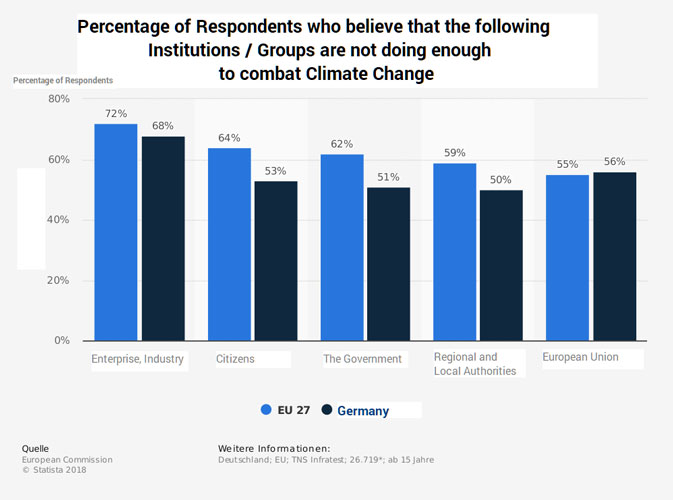Frequently Asked Questions
We have three main objectives:
- Provide Information about
a. current events related to ‘Balanced Ecology’ from an international point of view (Blogs);
b. the content and the method of CtoBEE - We are interested in knowing people (you!) who…
a. like to access our information and blogs;
b. like to exchange information and opinions with us and within their social network;
c. like to work with us to realize the innovative and game changing ‘product’ CtoBEE;
d. like to contribute with own activities or any amount (one time or regularly) to keep this page and all the background work up and running (see Contributions). - Welcome your contributions and / or look for investors (from 100.000 € up) to realize our next steps:
a. To found a legal entity (which will have the intellectual rights);
b. To write our handbook in a scientifically sound manner in cooperation with universities and companies;
c. Launch pilot projects with companies, customers, waste disposal companies;
d. Activation of the ‘Market Pull’ effect (starting with Europe)
It describes the attempt from a ‘space perspective’ reflecting an integrated approach, on the current problems of humanity´s living conditions and in accordance suggestions for improving them giving information and responsibility to the originators.
“Compass” is a number reflecting the degree of destroying, sustaining or improving our natural living conditions. “CtoBEE” is supposed to be a displayed attribute on commercial products.

The symbol reflects the four parts of the product-life-cycle: production – distribution -consumption – Recycling, Disposal. Each of these four parts is certified and the result is displayed in a color scheme according the EU Energy Efficiency label from green (best) to red or white, from 10 (best) to 1 or cero. In the center it displays the result of all the certificates in one number. This number represents the degree of ‘Improvement’ (regeneration) towards BEE (6 to 10) or ‘deterioration’ (degeneration) of BEE (0 to 5,9).
There are 7 innovative characteristics:
- CtoBEE covers the whole life cycle of products: production-distribution-consumption-waste management. Within the “production”, for instance, sector you could consider aspects of sustainable use of resources as well.
- CtoBEE informs the customer at a simple glance about the ecological impact of the product – complex information is transmitted simply.
- CtoBEE for the first time comprises different aspects (ecological, economic, environmental, resource usage) and is capable to reflect the information just in a key-number.
- CtoBEE leverages the trigger to “provoke Changes” from politicians, (international) companies to “the Market”. This “market pull” will have – from a ‘space perspective’ more direct and impacting results and give guidance for optimizing natural and economical resource allocation.
- CtoBEE causes rapidly ecological improvements in the industrialized hemisphere: he informs through direct and simple communication the critical mass of customers which in response influences the other participants of the product life cycle who respond with improved CtoBEE numbers. This is a Closed Feed Back Loop.
- In a long-term view the concept of CtoBEE might have the potential to enhance certain functions of “money” and the present economic system (which brought us where we currently are) and reflect change in persons and societies perceptions to ensure long-term evolution.
- CtoBEE could give Emerging Markets (where a growth of population above average is foreseen) references where and how to avoid the mistakes of first world and start directly with a sustainable evolution.
Because resources (like profit, taxes, water, air, earth) are NOT indefinitely and at will available. So, we should deploy them wisely.
Let’s have a look at 3 conceptual business models to get an idea of the seriousness of our situation:
- Let’s start with the economic model of a thriving company. Visualizing investment, expenses, revenue, benefit, over time it should look like this:

- Do you know the economic model of a company that has gone bankrupt? Visualizing investment, expenses, revenue, profit and operating losses, over time it should look like this:
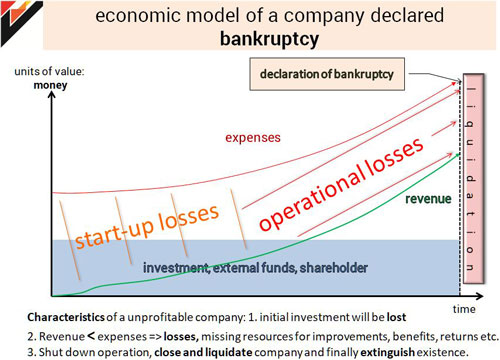
- Have you ever imagined how the business model of EARTH looks like? Let’s combine it with the management the human race has provided from beginning to present. Visualizing investment (=provided nature, resources, species etc.), expenses (= population, CO2 increase, one-time-resources extraction, unsustainable products, environmental pollution), revenue (= sustainable products, environmental equilibrium), benefit (=improving environment, increasing kind of species); including historic parameters the present situation of the company “EARTH” should look like this:
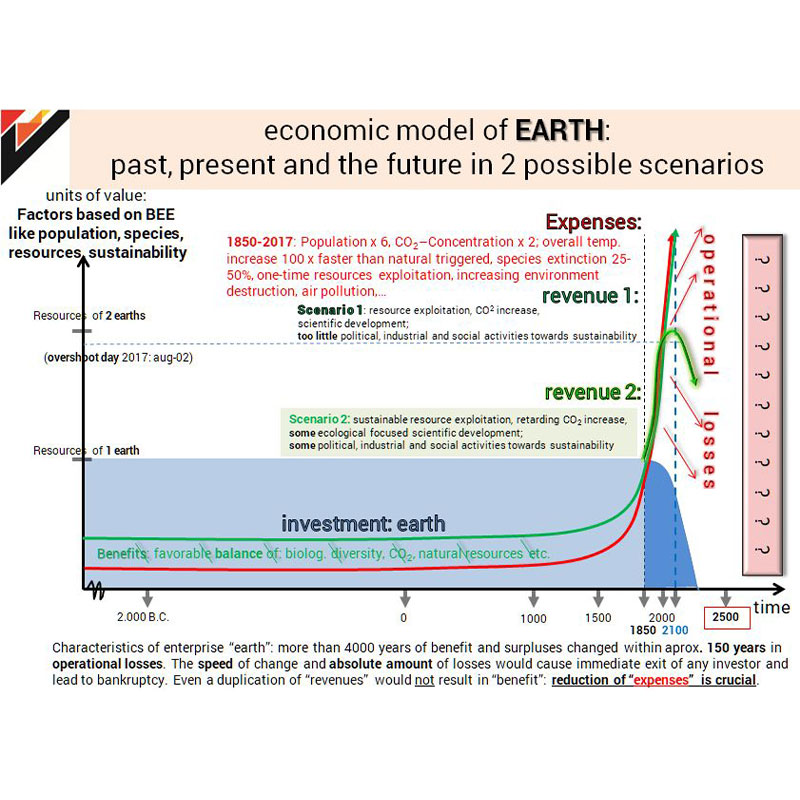
1. According to our “Business Model EARTH” it is crucial to reduce expenses. We face an unseen acceleration in too many essential threats to our habitat: there are the extinction of species, consequences of climate change, exploitation of one-time resources with known and still unknown side effects.
2. As the causes are worldwide the solution can only be based on a worldwide and an all-human being involved approach.
3. Today it is possible. Joining resources (by knowing where to allocate them best), streamlining intentions focused on “Improvement” (= “revenue 2” + BENEFIT), combining and thus potentiating actions: A single person, company, state, even continent can´t achieve the objective. Everybody is asked to participate. CtoBEE can stimulate and design the general framework.
4. Time is essential – the more people, companies, states, continents participate – the sooner there is “Improvement” – on a worldwide scale. Every excellent company has some ‘Hidden Reserves’ for emergency situations. The company ‘EARTH’, however, does have too little for the threats prevailing (like volcanic eruptions, melting of glaciers, increase of worldwide temperature, immense wildfires).
Let’s focus on the 3 most substantial variables of a business company like expenses, revenue, benefit and apply them to our Business Model “EARTH”:
Expenses are exploding means:
- Worldwide population is 6 times as high as in year 1 and keeps increasing.
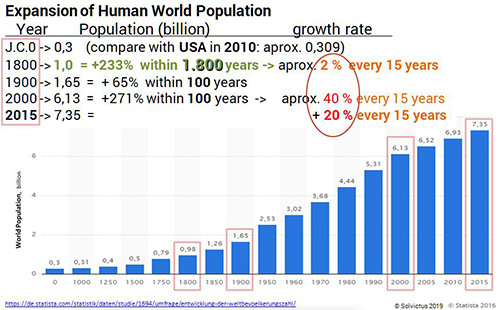
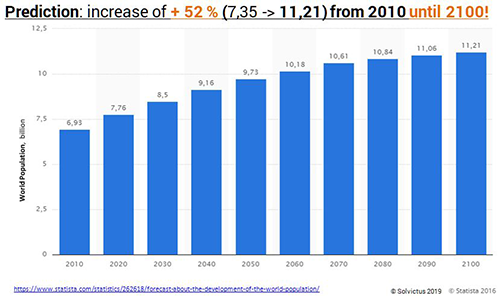
- Environmental pollution is escalating caused by evolving industrialization and the present intrinsic economic model.
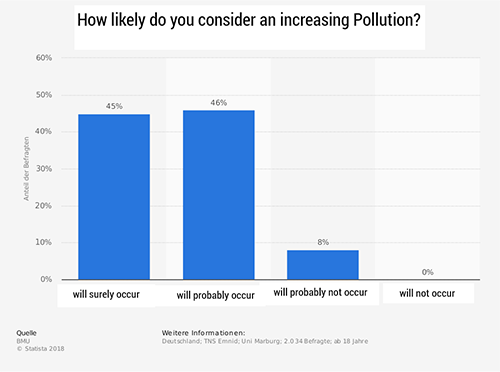
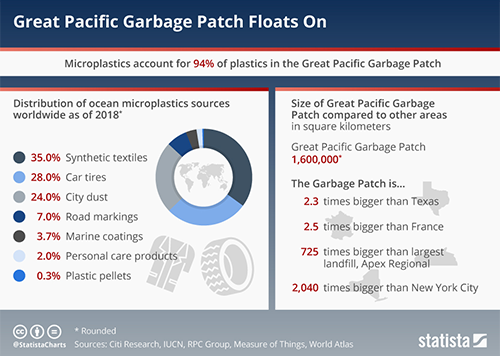
- Exploitation of the once basic “unlimited” and “free” resources like water, air, soil in an unsustainable way;
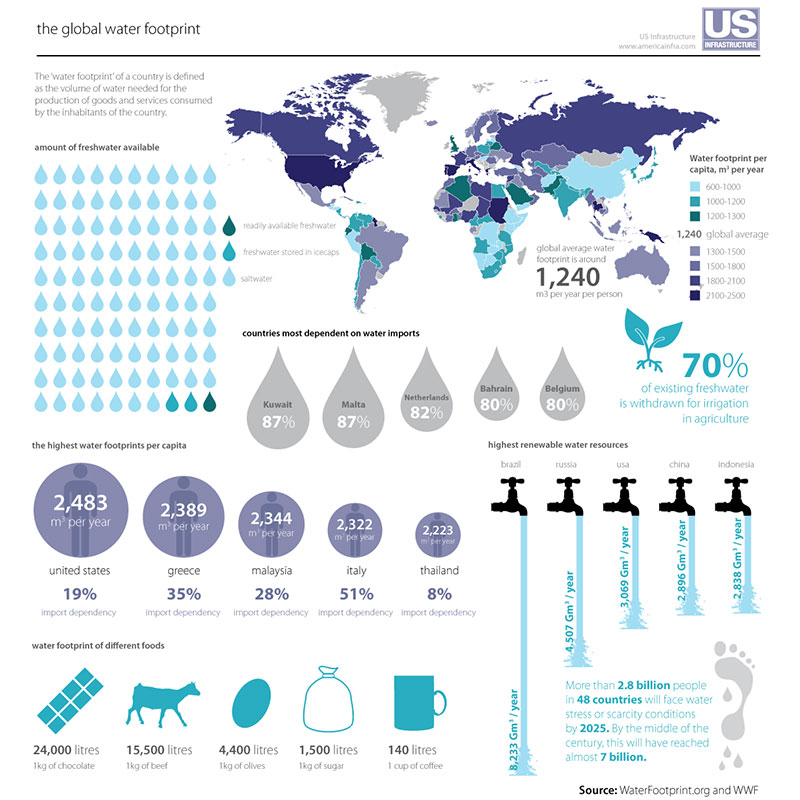
- Overall temperature increase is 100 times faster than natural triggered because of uncontrolled liberation of CO2 and CH4 (Methan).


- Worldwide species extinction is about 25 to 50%. Tendency: ongoing.

The course of time is crucial. Any action taken should aim to trigger improvement(-s) asap.
Your revenue is declining: one-time resources are exponentially exploited – based on scientific projections we already know when they will be consumed;
harvesting is not sufficient for the rising population; is in danger from weather phenomena due to climate change; yields are beefed up artificially partly without knowing the long-term effects on nature; clean water, fertile soil, clean air – all deteriorates.
Benefit like improving environmental conditions (not just “maintaining”) – does not exist, Long-term approaches to improving water, air and soil quality (not just returning to levels known from the past) – do not exist on sufficient and international levels;
Using less one-time resources in favor of sustainable resources – changes are underway, but actions are mainly taken by some high value market player (e.g., listed in stock exchange), normal companies – which represent the majority of companies – have difficulties to cope with the expenses. This means that we are far away from reaching the critical mass to stop ongoing destruction, not to mention to achieve “Benefit” (regeneration).
A too mayor part of the population is still not aware of their role and their responsibility to interfere.

They still don’t feel the motivation to contribute to make progress in direction “Benefit” possible.

Basically, it summarizes the effect of demand and supply: the producer informs the client at a glance (‘COMPASS’) about specific characteristics of his product and the customer buys it because it fulfills his desires, thus confirms the manufacturer’s former decisions regarding ecological tasks. The manufacturer continues to invest in ecological issues, informs the customer, the customer buys, etc. If we apply this cycle to economies, this ‘market pull’ causes continuous ecological improvement, continuous (!) reduction of CO2 (not only to 2 or 1.5ºC), fulfillment of the SDGs, and whatever the parameters selected intended. We can also say, ‘Market Pull’ represents a ‘Bottom Up’ approach because the customer decides. And therefore, he takes the responsibility. Not any politician, state, nor any company. The customer is the key to future.
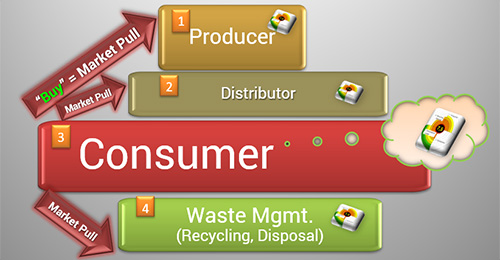
…Renewables and its development?
…Ecology and survival of humanity?
…Economics and welfare of industrialized nations?
…Philosophy and human behavior?
Based on the 7 characteristics mentioned above CtoBEE has a high potential to serve and guide us to achieve balance, harmony and appropriate living conditions despite of populations forecast, resource requirements and industrial and information evolution. All that from a ‘space view’ – we should be aware of having just one Earth for the next generations. With CtoBEE the responsibility is broken down to everybody. And each human being will assume some responsibility for earth’s future – meaning his own future – realizing that it is strongly related not only to the one next to us.
For Alexander Osterwalder “Innovation” combines three characteristics:
- Desirability
- Feasibility
- Viability
In a separate chapter you will find further information about these three criterias. Here we will just deliver the result: the desirability from society, enterprises and politics is very, very strong if you ask them separately. The major challenge is to combine those desires to an integrated approach where the different resources of all parties involved are invested efficiently.
To fulfill and guide these desires (‘Feasibility’) lead us to a quite complex but logical method. It is being supported and based on key enablers of high-tech tools. The method and the technology are both apt for international deployment.
A brief look in the confidential business plan (‘Viability’) of ‘CtoBEE’ offers an investment of about 4 million € for 4 years, in total about 16 million €. The return on Investment (“Earning Power”) will already begin after third year and will be finished after 4 years. Summing up, about seven years after having started there’ll be no debt left.
According to the three aspects considered, “Compass-to-Balanced-Ecology on Earth” can be judged as an Innovation, as A. Osterwalder says as a “Business R&D”.
The method of CtoBEE can include a wide range of different parameters like e.g. the 17 SDGs.
It is its key advantage that these parameters are not fix. They can be adapted according new scientific, social or technical developments. The SDGs cover a variety of different perspectives which are at the end of the day all linked to products and services. The following table gives a brief overview. Not all SDGs are applicable for all products or services.
| Sustainable Development Goals(SDGs)…*) | Verifiable through CtoBEE Category… |
| 1 No Poverty | Production, Recycling |
| 2 Zero Hunger | Production, Consumer |
| 3 Good Health | Production, Consumer, |
| 4 Quality Education | CtoBEE entity, Manual |
| 5 Gender Equality | CtoBEE entity, Production, Trade, Recycling |
| 6 Clean Water and Sanitation | Production, Recycling |
| 7 Affordable and Clean Energy | Production, Trade, Recycling |
| 8 Decent Work and Economic Growth | CtoBEE entity, Production, Trade, Recycling |
| 9 Industry, Innovation and Infrastructure | CtoBEE entity, Production, Trade, Recycling |
| 10 Reduced Inequalities | Production, Trade, Recycling |
| 11 Sustainable Cities and Communities | CtoBEE Manual, Production, Consumer, Recycling |
| 12 Responsible Consumption and Production | CtoBEE Manual, Production, Consumer |
| 13 Climate Action | CtoBEE entity, Production, Trade, Consumer, Recycling |
| 14 Life Below Water | CtoBEE Manual, Production, Consumer, Recycling |
| 15 Life on Land | CtoBEE Manual, Production, Consumer, Recycling |
| 16 Peace, Justice and Strong Institutions | CtoBEE entity, CtoBEE Manual, Consumer |
| 17 Partnership for the Goals | CtoBEE entity, CtoBEE Manual |
_______________________________________________
*) Source: https://sdgs.un.org/goals
The degree of compliance with the specific SDG’s can be documented and reflected in the CtoBEE evaluation. On one hand, it would allow manufacturers to communicate their efforts in this specific SDG. On the other hand, it would inform the consumer whether the product or service meets his criteria and expectations. His purchase signals positive feedback to the manufacturer. The ‘Market Pull’ effect is created.
“The Climate Change is out of Control” confessed António Guterres, Secretary General of the United Nations in July 2023. If a CEO of any company were to publish a similar message about his company, it would be tantamount to declaring bankruptcy. It seems that we are getting more and more evidence of our ‘Business-Model EARTH‘. One advantage of CtoBEE is the comprehensive guidance of all stakeholders (customers, companies, waste management facilities, politicians) regarding ecology, not only CO2-reduction. If CtoBEE had already been running for 3 years, Mr. Guterres would most likely be able to formulate his statement differently today (2023). CtoBEE passes responsibility and control to the base of our society (customers, “Bottom”). It is up to them in which way they shape the future (“Bottom-Up”): constructive or destructive. In either way, being the origin and cause of the development, the base cannot blame politics or companies for failure. It can only motivate himself to reach sufficient people to get the turn right (“critical mass”).
For all of the stakeholders, these are complex issues: Renewables, ecology, supply chain act, circular economy, Nutri-Score and so on. The almost confusing number and different design of the available labels make it almost impossible for the customer to keep an overview or to find his way around. Who does and will have an overview? We need simplification and guidance toward ecology.The working topics related to CtoBEE can be seen as a new professional subject like accounting, administration, human resources or information technology. As such it can also be outsourced because it does not necessarily demand capabilities which are close related to the company’s core competence. And mostly bigger companies can afford to hire specialists for each new upcoming topic. SMEs have more difficulties.
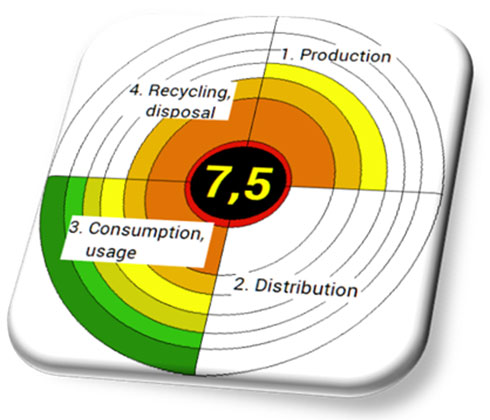 CtoBEE visualizes at a glance the results for customers unifying all the labels, parameters selected for the product. It simplifies communication between stakeholders and gives feedback between them. With this feedback it will be easier for companies to focus their resource allocation efficiently.
CtoBEE visualizes at a glance the results for customers unifying all the labels, parameters selected for the product. It simplifies communication between stakeholders and gives feedback between them. With this feedback it will be easier for companies to focus their resource allocation efficiently.
The customer as well as the waste management company receive information about the product and how it is to be disposed of. The customer should no longer have any doubts about what, where and how to dispose of the product. Inter/national differences in disposal will also disappear. And the waste management industry will be judged by the extent to which it can feed recyclable materials back into the economic cycle. Likewise, how ecologically it carries out the disposal of residual materials.
After the successful introduction of CtoBEE in the world of business, policy makers can take it up for their goals. This should be possible five years after the start of the project.
Today the greatest risk for humanity will occur if we are too slow to react, if we keep thinking that the same (economic and political) systems that brought ‘devastation’ will bring ‘salvation’ by using the same ‘ingredients’ (borrowed money which is finite, Top-Down approach by implementing political decisions reaching just parts of the worldwide population or companies), if we do not succeed to streamline and focus our resources: many, many people and animals will suffer and die. It is our (as customers) free decision – on a daily basis. We should realize that the problems we are facing have been caused by all of us – so it only can be fixed by all of us, or at least sufficient people and companies (‘critical mass’) to turn around the development.
